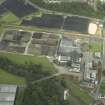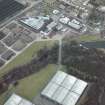Pricing Change
New pricing for orders of material from this site will come into place shortly. Charges for supply of digital images, digitisation on demand, prints and licensing will be altered.
Cambus, Iron Bridge
Footbridge (19th Century)
Site Name Cambus, Iron Bridge
Classification Footbridge (19th Century)
Alternative Name(s) Cambus, Iron Footbridge; Cambus Distillery, Cast Iron Bridge; Devon Place; River Devon
Canmore ID 47215
Site Number NS89SE 52
NGR NS 85325 94078
Datum OSGB36 - NGR
Permalink http://canmore.org.uk/site/47215
- Council Clackmannan
- Parish Alloa
- Former Region Central
- Former District Clackmannan
- Former County Clackmannanshire
NS89SE 52 85325 94078
See also NS89SE 67.
(Listed with Cambus Distillery [NS89SE 67]: location cited as NS 853 940). An early 19th-century cast iron arch bridge over the River Devon, recently restored.
J R Hume 1976.
This short footbridge crosses the River Devon about 630m NE of its debouchement into the River Forth, and to the SW of Cambus Distllery (NS89SE 67). It is depicted, but not noted, on the 1991 edition of the OS 1:10,000 map.
Information from RCAHMS (RJCM), 2 June 2006.
Construction (1825 - 1840)
Possibly cast and erected by Carron iron Company. Exact construction date unknown.
R Paxton and J Shipway 2007
Note (1978)
Cambus NS 853 940 NS89SE
Early 19th-century cast-iron bridge; recently restored and still in use
for vehicular traffic.
RCAHMS 1978
(Hume 1976, 87)
Project (2007)
This project was undertaken to input site information listed in 'Civil engineering heritage: Scotland - Lowlands and Borders' by R Paxton and J Shipway, 2007.
Publication Account (2007)
This bridge, for its time, is a cast-iron segmental arch structure of 65 ft span and 7 ft rise erected across the
Devon near its confluence with the Forth, probably between 1825 and 1840. Local opinion favours the earlier
date and that the bridge was cast and erected by the Carron Company. Its 12 ft wide timber deck is supported
on four ribs thought to be of local design. Each rib is composed of five elements – three 2 ft deep members buttjointed on transverse diaphragms at third points and two tapered members at the ends on top of the arch-rings.
The bridge, which originally carried horse-drawn traffic, was conserved ca.1975 under the direction of Ronald
Noble, consulting engineer, Alloa, as part of a riverside walkway project.
R Paxton and J Shipway 2007
Reproduced from 'Civil Engineering heritage: Scotland - Lowlands and Borders' with kind permission from Thomas Telford Publishers.






























































